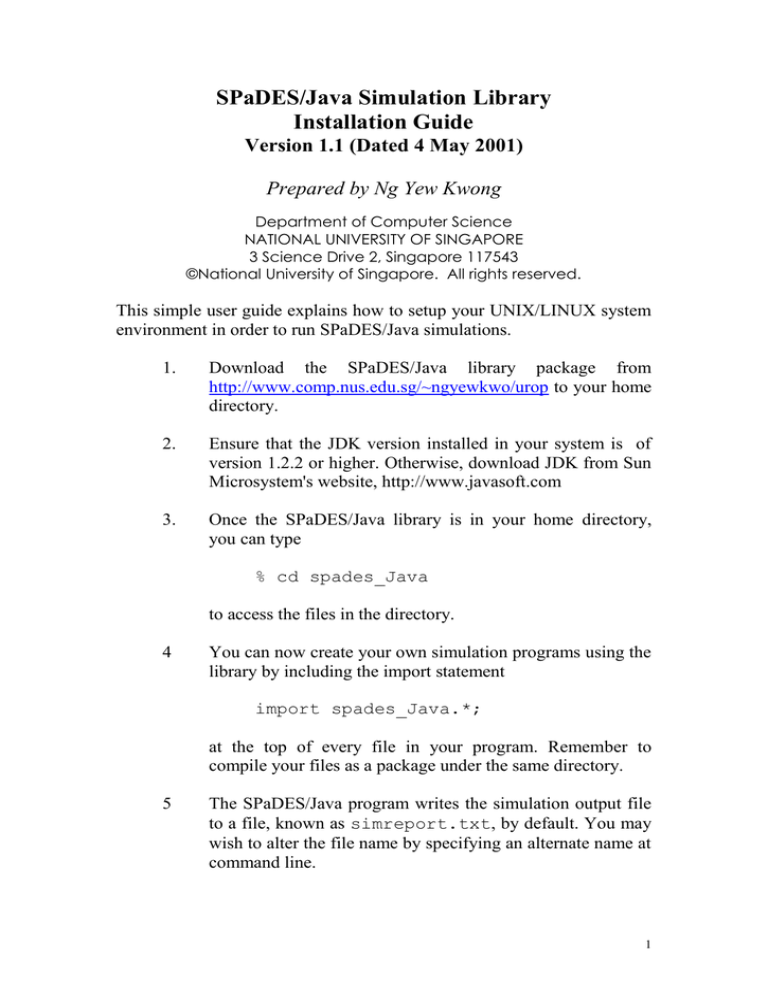
SPaDES/Java Simulation Library
Installation Guide
Version 1.1 (Dated 4 May 2001)
Prepared by Ng Yew Kwong
Department of Computer Science
NATIONAL UNIVERSITY OF SINGAPORE
3 Science Drive 2, Singapore 117543
©National University of Singapore. All rights reserved.
This simple user guide explains how to setup your UNIX/LINUX system
environment in order to run SPaDES/Java simulations.
1.
Download the SPaDES/Java library package from
http://www.comp.nus.edu.sg/~ngyewkwo/urop to your home
directory.
2.
Ensure that the JDK version installed in your system is of
version 1.2.2 or higher. Otherwise, download JDK from Sun
Microsystem's website, http://www.javasoft.com
3.
Once the SPaDES/Java library is in your home directory,
you can type
% cd spades_Java
to access the files in the directory.
4
You can now create your own simulation programs using the
library by including the import statement
import spades_Java.*;
at the top of every file in your program. Remember to
compile your files as a package under the same directory.
5
The SPaDES/Java program writes the simulation output file
to a file, known as simreport.txt, by default. You may
wish to alter the file name by specifying an alternate name at
command line.
1
However, if the program involves multiple runs, say 3 runs,
then the output file for each of the runs will be generated and
stored in a file with the default or given name appended with
the number of the run. For example, if the name was
specified as torus, then the 3 files generated are
torus1, torus2, torus3
Each file comprises of a combination of the user report,
system report or both, and may include interval reports,
depending on the choice of the user.
2
The following is a summary of the different command line parameter
options available to the user at runtime.
Option
-a <algorithm>
Role and Usage
Specify the type of simulation mechanism required for the
current simulation.
0 - Single processor (default)
1 - Multiple processors
-d
<duration>
Specify the simulation duration in time units.
Default - use the duration specified in
startSimulation() in the program.
-f
<period>
Specify the run-in period of the simulation
Range : 0 <period> <duration>
Default : 0
-h
Display the list of parameter options and brief descriptions
of their usage to aid the user.
-o
<output>
Specify the type of statistical reporting required.
0 - user report (default)
1 - system (mechanism) report
2 - both (user and final) reports
-p
<filename>
Specify the file to write the statistical report(s) to.
default - simreport.txt
-r
<number of runs>
Specify the number of runs of the simulation required
Default : 1
-s
<seed value>
Specify the seed value to be used for this simulation.
Range : 0 <seed value> 9
Default : 0
-t
<time>
Turns interval reporting on with time interval <time>
between subsequent reports.
Default - off (if interval reporting is not activated)
- 50 time units
(if interval reporting is activated and the
interval time is not specified)
3





